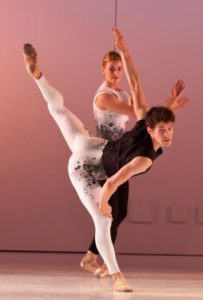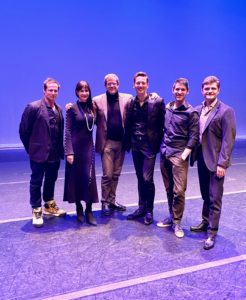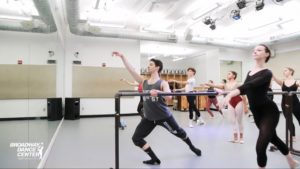
CVDA is excited to share insight on the lives and accomplishments of our Alumni. Barry Kerollis trained at CVDA and moved on to perform with numerous professional ballet companies and is the Artistic Director of Movement Headquarters Ballet Company. He is currently a choreographer and educator in New York City on faculty at Broadway Dance Center. In addition, Barry writes for Dance Media publications and hosts the Pas de Chát: Talking Dance podcast on the Premier Dance Network through which he offers insight into the world of dance. Barry was gracious enough to reflect on his CVDA studies and how it impacted his finishing training and professional career.
When did you train at Chester Valley Dance Academy and what were some of your favorite memories/performances/events?
I spent about 10 years at CVDA from 1990 until 2001 when I left home to finish my training at the Kirov Academy of Ballet in Washington, DC. As I get older and with so, so many experiences as a dancer, some of my favorite memories of performing at that age are beginning to fade. But what I remember most from my time at CVDA was the immense amount of support I received from my teachers, peers, and the families at the school. CVDA instilled in me a sense of passion for dance, the arts, and humanity in general.
As my passion in dance grew, my mentors (especially Miss Cathy and Miss Kim) did everything in their power to make sure that I had opportunities, that I was supported, and that I had a home whenever I returned. When our cohort of students started to push beyond what the school had to offer, Cathy stepped up to the plate and made sure the school grew with and for us. I distinctly remember her answering our call by providing additional classes, hiring more instructors with professional credentials, and cultivating new programs (including a competition team, additional performance opportunities, and more). CVDA built the foundation for me to have a wonderful career as a dancer and instilled the passion in me to become an advocate for dance as a director, choreographer, and influencer within the greater dance community.
What studies/training did you pursue after CVDA and how did your experience and training at CVDA help you prepare for this?

During my final years at CVDA, I found great value in attending summer intensive programs. I spent two summers at the Houston Ballet Academy and one with American Ballet Theatre. These opportunities gave me an inside peek at what it would be like to prepare for a career as a ballet dancer and helped me make the strategic decision to turn my focus to ballet. I left home my senior year to attend the Kirov Academy of Ballet and spent the last year of my training at the School of American Ballet in New York City. As I stated previously, CVDA gave me a strong foundation to work from and instilled a sense of passion and hard work in me to succeed in these programs and obtain a job in the dance field.
One of the biggest benefits from my time at CVDA didn’t become obvious until a few years into my career. As the ballet world has evolved, dancers are asked to be more and more versatile in differing styles. Where many dancers around me struggled with newer styles of movement, I found it much easier to adapt to new choreography thanks to the various genres I trained in during my time at CVDA.
Can you provide some insight into what it is like performing with a professional ballet company? What are some of the greatest challenges and greatest rewards?

Performing full-time with a ballet company is one of the greatest rewards of many years of hard work and difficult training. I fondly remember standing onstage hearing the orchestra tune, smiling at my friends under bright lights, and taking one final breath as the curtain rose to audiences of nearly 3,000 people. During my 12 years dancing professionally, I often performed up to 120 times a year, learning anywhere between 15-20 works a year, working with world-renowned choreographers, and seeing myself and peers appear in dance periodicals. Having the opportunity to have a professional career in dance is a dream. And while it isn’t always seen as the most lucrative option, I am so rich in life experiences that I can’t even see the comparison.
Of course, a career in dance is extremely challenging. The training is immensely difficult, the competition is extremely intense, and the physical and emotional toll of succeeding and failing at something you pour yourself whole-heartedly into can be overwhelming. But in times of happiness, we dance. In times of challenge or sadness, we express ourselves physically. We are all dancers. But only a few of us are lucky enough to make our life and living from this most human expression.
What are you doing now and how did you get there? What would you like to share with the CVDA Community about your current work?
What I have learned throughout my career is that there are no straight lines or pathways towards our goals. Since retiring from performing in 2016, my life and career have taken me in many directions. Currently, my proudest and most recent achievement has been to launch a new dance company in New York City, Movement Headquarters Ballet Company. As both Artistic Director and Choreographer, this past February I created a 2-hour program featuring my choreography and 12 dancers at the Alvin Ailey Citigroup Theater in Midtown Manhattan. Beyond this, I am now working as a judge and master educator for Youth America Grand Prix, work as faculty at Broadway Dance Center and Steps on Broadway, write for Dance Magazine and their affiliate periodicals, and host the Pas de Chát: Talking Dance podcast on the Premier Dance Network.
I have never shied away from putting more than 100% of myself into developing my career, whether it be as a dancer, choreographer, educator, or director. As I gain traction within the greater dance community, what I have learned is that my candor, eagerness to learn about the art form both inside and beyond the studio, and humanity are what draw my community towards my work and voice. We often see where we want to go and are afraid of being pulled off that path. But I’ve learned that you can still remain focused on that end goal and gain so much more along the way by learning other aspects within and parallel to your field of choice.
Can you discuss your transition from a “dancer” to a “choreographer”?

I call myself an accidental choreographer. I co-choreographed a jazz piece with Miss Cathy during my final year at CVDA. Then, the following year, I failed miserably at creating a solo for myself while at the Kirov Academy of Ballet. In fact, I asked a friend to finish the last minute of a 2 minute solo. Something changed in me during my time at Pacific Northwest Ballet and I signed up for a choreography workshop. What was different this time was that I had a better understanding of how music felt in my body and how that could be translated into movement. This time, once I started developing choreography, it felt extremely natural for me and I started to fall in love with it.
At this point, I was very much in the thick of my performance career and unwilling to throw all of my focus into choreography, considering how short a career in dance can be. Once I started to realize that my transition out of my performance career was happening, I wholeheartedly threw my attention to fine-tuning my skills as a dance maker and started seeking additional opportunities to create. It was a very seamless transition that I didn’t realize was happening until after it already had. The best part about being a choreographer today is that while I am technically retired from dance, it is still very much a part of everything that I do. I am in the studio moving my body almost every single day.
What advice do you have for CVDA dancers that want to pursue dance/dance studies after high school?

First and foremost, you need to be educating yourself about many different styles of dance. Every single school in the country has its own culture and practices. This means that many dancers are only getting a small view into the world of dance. Read magazines, watch videos on YouTube, see performances locally and in big cities, and attend auditions for programs that you wouldn’t dream of attending. There are so many different pathways to a dance career and it is your responsibility to find the path that you are passionate about. Once you find your passion, you must be willing to give up so much and focus on your training, as well as your physical and emotional health, to survive and thrive. Getting to a dance career and maintaining it is a difficult task. But the experience of getting to live and breathe as a professional dancer is so unique and fascinating. Very little can compare to it.
Follow Barry
Movement HQ Website: movementhqballet.org/
Personal Website: barrykerollis.com/
Instagram: @BKerollis
Facebook: Barry Kerollis
Pas de Chát podcast: www.premierdancenetwork.com/pas-de-chat/
You must be logged in to post a comment.